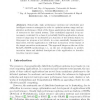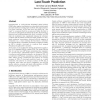535 search results - page 10 / 107 » Predicting Application Run Times Using Historical Informatio... |
CHI
2005
ACM
14 years 8 months ago
2005
ACM
The Keystroke-Level Model (KLM) has been shown to predict skilled use of desktop systems, but has not been validated on a handheld device that uses a stylus instead of a keyboard....
HPCC
2005
Springer
14 years 1 months ago
2005
Springer
Historically, high performance systems use schedulers and intelligent resource managers in order to optimize system usage and application performance. Most of the times, applicatio...
ISNN
2010
Springer
13 years 6 months ago
2010
Springer
Abstract. A forecasting approach based on Multi-Layer Perceptron (MLP) Artificial Neural Networks (named by the authors MULP) is proposed for the NN5 111 time series long-term, out...
ISCA
2000
IEEE
13 years 12 months ago
2000
IEEE
Communication in cache-coherent distributed shared memory (DSM) often requires invalidating (or writing back) cached copies of a memory block, incurring high overheads. This paper...
CSE
2009
IEEE
13 years 8 months ago
2009
IEEE
In Mobile Social Networks (MSN) individuals with similar interests or commonalities connect to each other using the mobile phones. MSN are special kind of Ad-hoc Networks in which ...


